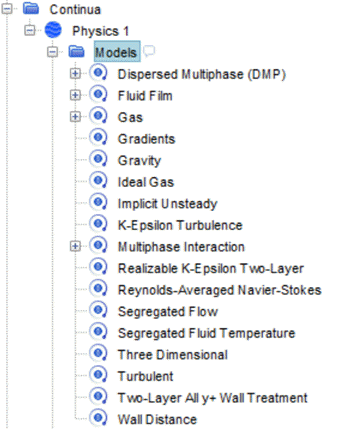Selecting Physics Models
In the DMP approach, single-phase flow models are used to simulate the continuous gas phase, which in this tutorial is air. The dispersed phase is water droplets.
By default, DMP is one-way coupled: the background air flow can influence the dispersed liquid phase (for example, through drag force and heat transfer) but not the reverse (that is, the air flow affects the water droplets, but the droplets have no effect on the air). The only way in which the dispersed phase can influence the physics continuum is through impingement onto a liquid film.
Two-way coupling is optional in a DMP simulation. When two-way coupling is activated, the dispersed phases can influence the physics continuum. Drag force and heat transfer contribute to all phases, and the volume of the dispersed phases is subtracted from the available volume for the background phase. You activate two-way coupling when you expect a dispersed phase to have a significant effect on the continuous phase. However, in this case, the influence of the dispersed phase on the continuous background phase is assumed to be insignificant and is neglected.
At this stage, select the single-phase models that represent the unsteady air flow as an ideal, turbulent gas, subject to gravity. Choose the Dispersed Multiphase model to solve for the water phase as droplets, and the Fluid Film to solve for the water phase on the surface of the airfoil. You also require the Multiphase Interaction model, to define the influence of the gas phase on the droplet motion and energy, and the impingement of the droplets onto the water film phase.
-
For the physics continuum,
, select the following models in order:
Group box Model Enabled Models Three Dimensional (Selected automatically) Time Implicit Unsteady Material Gas Flow Segregated Flow
Gradients (Selected automatically)
Equation of State Ideal Gas Energy Segregated Fluid Temperature Viscous Regime Turbulent
Reynolds-Averaged Navier-Stokes (Selected automatically)
Reynolds-Averaged Turbulence K-Epsilon Turbulence
Wall Distance (Selected automatically)
Realizable K-Epsilon Two-Layer (Selected automatically)
Two-Layer All y+ Wall Treatment (Selected automatically)
Optional Models Fluid Film Dispersed Multiphase (DMP) Multiphase Interaction Gravity - Click Close.
-
To review the models, open the node.

- Save the simulation.